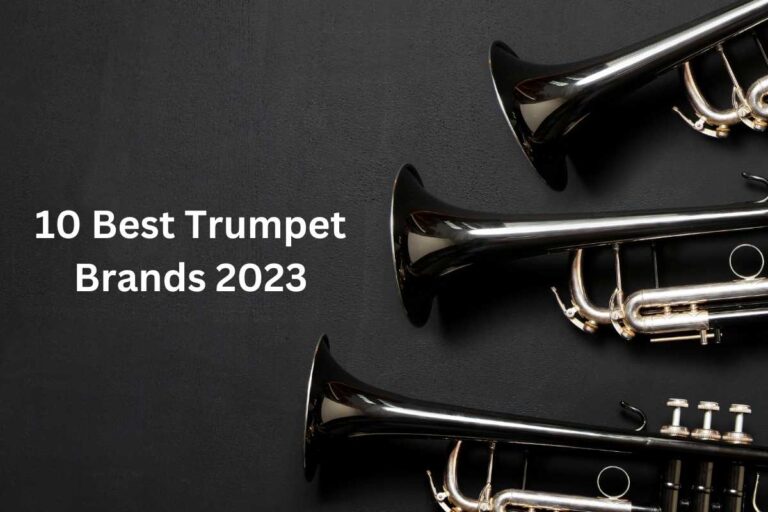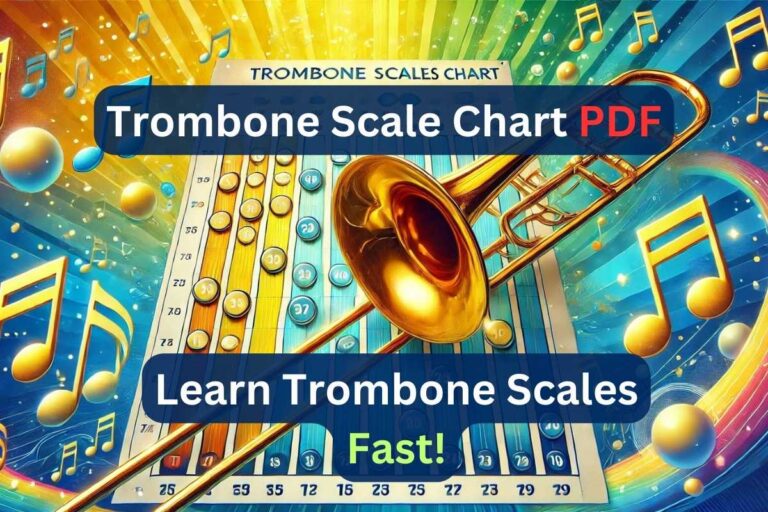Master Double Tonguing Trumpet Exercises — Ultimate Guide With 5 Sheet Music PDFs
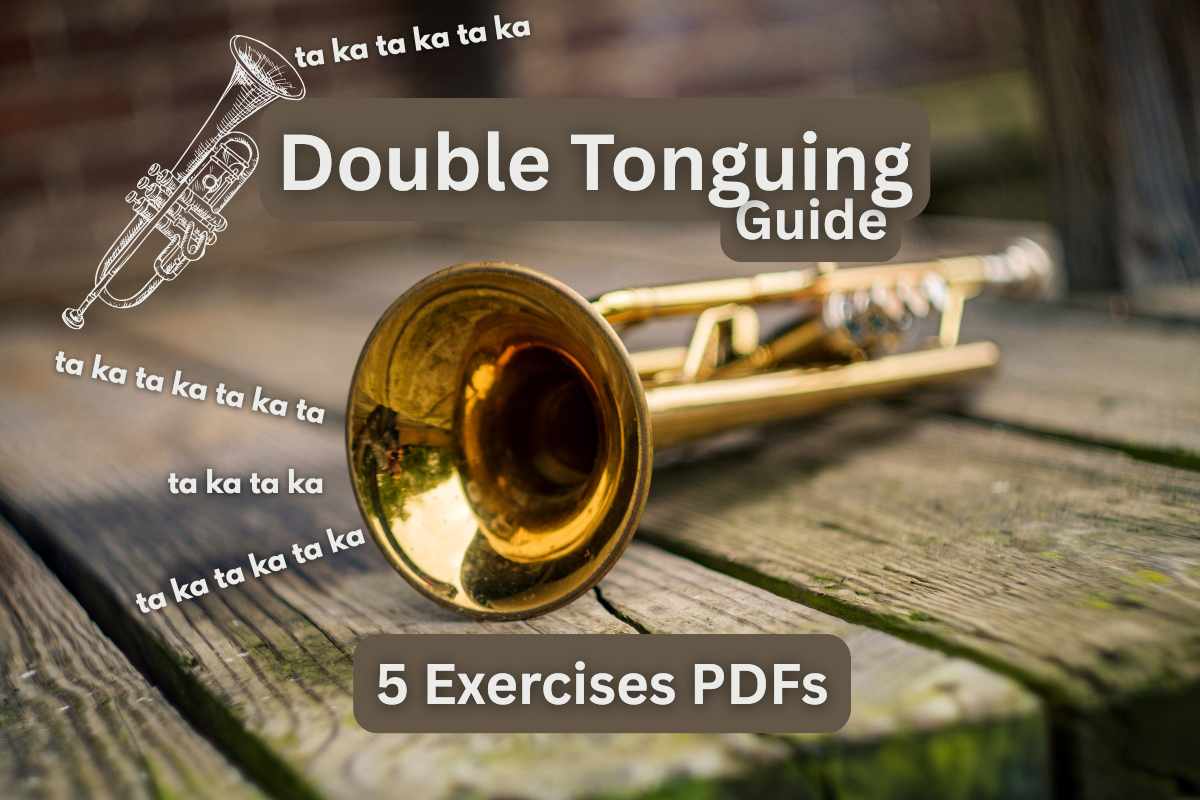
Double tonguing trumpet technique is ALL about making “ku” sound like “tu.” Using “tu ku tu ku” lets you play way faster than single tonguing. But here’s the kicker — no one should hear the difference between the two syllables.
We practice “ku” not because it’s different, but because it needs to sound the same. The syllables are just training tools. Once mastered, you’ll articulate twice as fast with perfect evenness.
The exercises in this guide will get you there! Let’s dive into!!
What Is Double Tonguing Trumpet?
Double and triple tonguing work by alternating tongue positions to create rapid articulations. Instead of relying solely on the tip of your tongue with “ta” syllables, you incorporate the back-middle portion using “ka” sounds.
Think of double tonguing like guitar playing – rather than only strumming down, you alternate between down and up strokes for increased speed and efficiency.
The key principle is maintaining constant airflow throughout the process. Imagine playing a whole note. When you add articulation, your tongue interrupts this airstream into smaller segments.
Double tonguing trumpet confuses trumpeters because you practice “Ta” and “Ka” separately, but the goal is to make them sound even!
You’re training two tongue positions to create identical attacks. “Ta” uses your tongue tip, “Ka” uses the middle/back section. Both need equal strength and precision.
You’re not making “Ka” sound like “Ta” exactly. You’re making both syllables create identical note attacks. The tongue motions differ, but the musical result stays THE SAME!
Learning Method — Example
Start with triple tonguing before double tonguing. This might seem off, but learning “Ta-Ta-Ka” first prevents the common problem of adding an extra “ta” to double tonguing patterns.
Use the “TTK” pattern rather than “TKT” for triple tonguing. Practice inverted patterns — “Ka-Ka-Ta” for triple, “Ka-Ta” for double — to strengthen the “ka” syllable and make regular patterns feel easier.
When you are confident with triple, go for double! Start by speaking the pattern slowly and clearly: “Ta-Ka, Ta-Ka, Ta”! Practice this as a tongue twister until the syllables flow naturally. Keep your jaw relaxed and avoid tensing up.
Then, add airflow. Incorporate breathing while maintaining the syllable patterns. Blow air through your lips as if using a straw, tonguing the same combinations. This step bridges the gap between speech and playing, helping you maintain airflow while articulating.
Apply to the Instrument — begin on a comfortable middle register note (F or G on the staff). Play long tones while adding the tonguing patterns. Don’t worry about changing pitches yet — focus entirely on evenness and clarity.
Practice Applications
Begin all exercises on single notes before adding pitch changes. Once comfortable, expand to:
- Scale patterns —one tonguing sequence per scale degree
- Interval leaps between sequences. Check out “Trumpet Range Exercises PDF — 5 Top Options Every Trumpist Should Practice Today“
- Scales within sequences
Never use “tut” syllables, as this doubles your effort by both starting and stopping each note with your tongue. Remember that the end of one syllable naturally becomes the beginning of the next.
Recording and Self-Assessment
Record yourself regularly during practice. Many players think their trumpet double-tonguing sounds uneven when it ACTUALLY sounds perfectly fine to listeners. Recording provides objective feedback and builds confidence in your technique.
Tongue Movement Efficiency
Practice “wiggling” your tongue between front and back positions, first without air, then while blowing. The air pressure helps your tongue bounce off the roof of your mouth more easily, reducing effort and enabling faster speeds.
Airflow Consistency
Maintain warm, relaxed air pressurized from your core and constantly moving. Your tongue should lightly intercept this airstream rather than driving the articulation with throat movements. Avoid closing your teeth too much or tensing your jaw.
1. Double Tonguing Trumpet from Legendary Arban’s Method Book
The original Double Tonguing Trumpet exercises in J.B. Arban’s method book range from Etude 77 to Etude 114. But for this guide, I’ve included only up to Etude 90 — because honestly, that’s more than enough to build solid double-tonguing.
These 13 exercises cover everything from clean articulation to speed, endurance, and accuracy. Once you can play these smoothly, you’ll be ready for anything in your music!
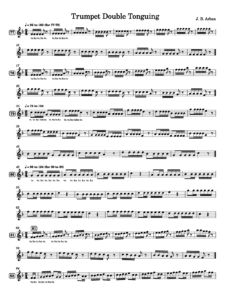
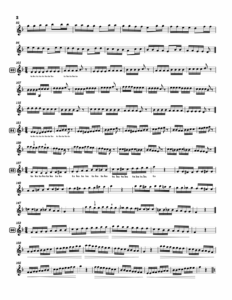
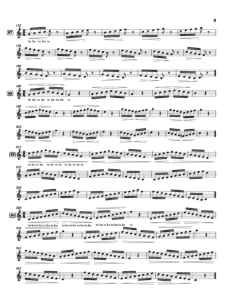
Exercise Details:
- Key Signature: Vary. It uses Eb major while others are in Bb major + a few brief modulations.
- Time Signature: Predominantly 2/4 and 4/4
- Tempo: Ranges from ♩ = 72 to 160 BPM
- Articulation: “tu-ku” syllables are marked under the notes for practice clarity.
The etude starts with slow, even eighth notes and gradually increases in complexity. As you flip through each line, you’ll notice triplets, sixteenth notes, and longer sequences.
Anecdote: Many PROs say they still revisit this etude before auditions—“It’s like brushing your teeth, but for chops!”
Many trumpet teachers consider these exercises the “gold standard” for double tonguing development. They appear in conservatory curricula worldwide and remain relevant after 150+ years. Forums like “Trumpet Herald” frequently discuss these specific exercises and their benefits.
2. Double Tonguing Trumpet — Exercise 2
“Double Tonguing Trumpet Exercise 2” spans 36 measures with multiple sections. You’ll meet accidentals (sharps and flats) across scores.
The notation includes fingering numbers. These numbers — 0, 1, 2, 3 — correspond to trumpet valve combinations. Open (0) means no valves pressed, while numbers indicate which valves to press.
TIP: Use alternate fingerings when needed. Try some notes with different valve combinations. Choose fingerings that create the smoothest transitions. For more details, check out my post with “Best B Flat Trumpet Fingering Chart PDF + 12 Notes“!
Each line includes rest marks ( // ) — caesura. These indicate where you should pause and breathe. Keep breathing and maintaining consistent airflow.
Exercise Details:
- Key Signature: Bb major
- Time Signature: 4/4
- Tempo: ♩ = 100 to 150 BPM
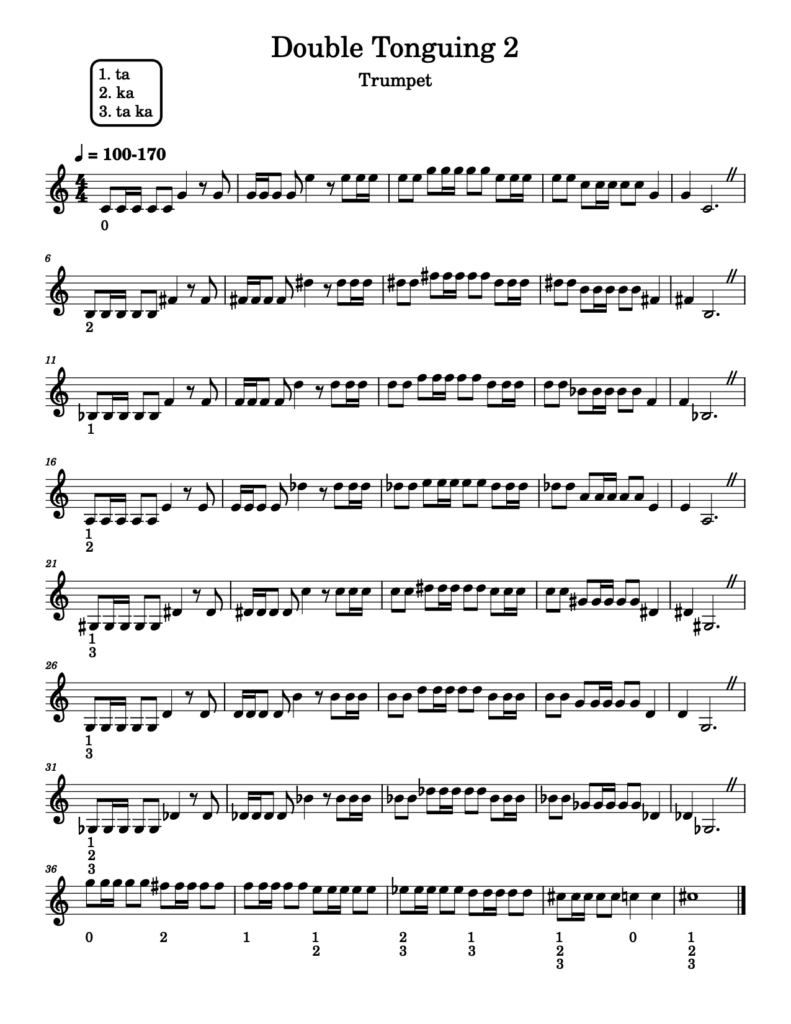
Start with the basic “ta-ka” pattern. Keep your airflow steady and consistent. Focus on making both syllables sound equally clear and strong.
Don’t rush the tempo until both “ta” and “ka” sounds are even.
Watch for the transition between natural and sharp notes. Your tongue technique SHOULDN’T change, only your fingering. Maintain the same articulation quality throughout. Focus on finger independence from tongue movement.
Break complex sections into smaller chunks. Practice 2-3 measures at a time before combining them.
3. Double Tonguing Trumpet — Rhythm Studies
The double tonguing trumpet “Rhythm studies” is another set of fast trumpet exercises. You’ll find five original rhythm studies plus three real-world excerpts (from pieces like “Loop” and “Ghostlight”).
The exercise follows a progressive difficulty structure. Each study builds upon previous skills while introducing new challenges. The form moves from simple rhythmic patterns to complex syncopations and finally to real musical excerpts.
Exercise details:
- Structure: Rhythm studies and excerpts from classical pieces
- Tempo: Ranging from 120 to 180 BPM
- Time signature: Multiple, including 4/4, 6/8, and 12/8

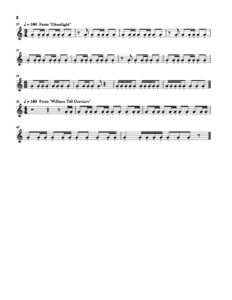
Double-tonguing Rhythm studies start at a comfortable 120 BPM in 4/4 time. It begins with whole notes and quarter notes before progressing to eighth-note patterns. It sets up tongue coordination before increasing difficulty.
Exercise 2 jumps to 180 BPM in 12/8 time and syncopated rhythms. Exercise 3 returns to 4/4 time at 160 BPM with sixteenth note patterns.
Exercises 4 and 5 use 6/8 and 12/8 time signatures, aiming for the “Ti-Ka-Ti” tonguing pattern. The tempos (174 and 172 BPM) push you toward performance-level speeds.
The three excerpts come from “Ghostlight,” “Loop,” and “William Tell Overture.” These real musical examples show how double tonguing applies in actual repertoire. The “William Tell Overture” excerpt is particularly famous for requiring rapid articulation.
All exercises use staccato throughout. The short note style helps with the “crisp” tongue action. Syncopated patterns teach how to maintain internal pulse. The compound time signatures (6/8 and 12/8) prepare players for triple tonguing applications.
Conclusion — Double Tonguing Trumpet
Multiple tonguing develops over months and years of consistent practice. Focus on evenness over speed – if your pattern sounds like galloping or one syllable is louder than another, slow down until everything is controlled. The goal is to make “ta” and “ka” syllables indistinguishable in volume, clarity, and timing.
Keep learning the trumpet and check out “7 Proven Trumpet Lip Slurs Exercises PDF — Student-Friendly and Easy to Follow Guide!“






